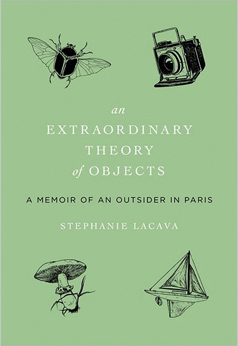Stephanie LaCava's life told in extraordinary objects
 I read Stephanie LaCava's book in great gulps last month, falling hard for it both professionally as a reviewer and personally as a reader. In just over 200 pages and full of pen & ink illustrations and diversionary footnotes, An Extraordinary Theory of Objects: A Memoir of an Outsider in Paris begins when LaCava's family moved to France for her father's job. At only twelve-years old and a self-described strange child, she took the move exceptionally hard and found herself clinging to objects from home while also seeking out more things to collect in her new country. The chapters highlight this penchant for noticing and acquiring things - for seeing objects for more than their material worth - and also places she visited as well as more traditional coming-of-age episodes involving family and friends.
I read Stephanie LaCava's book in great gulps last month, falling hard for it both professionally as a reviewer and personally as a reader. In just over 200 pages and full of pen & ink illustrations and diversionary footnotes, An Extraordinary Theory of Objects: A Memoir of an Outsider in Paris begins when LaCava's family moved to France for her father's job. At only twelve-years old and a self-described strange child, she took the move exceptionally hard and found herself clinging to objects from home while also seeking out more things to collect in her new country. The chapters highlight this penchant for noticing and acquiring things - for seeing objects for more than their material worth - and also places she visited as well as more traditional coming-of-age episodes involving family and friends.
As a title for teens it is a major winner and while I can understand its publication for adults, I really see this as classic crossover territory. (I especially like that it follows the author into her adulthood so YAs can see how she navigated what was clearly a difficult adolescence.)
My personal reaction to the book was much deeper however, almost visceral. In moments of upheaval in my own life there have always been certain objects that I cling to - some of which have been with me for decades. My maternal grandfather's foot locker (made for my parents when my father was in the military - his name/rank/serial number are still visible on the top), the 4 leaf clover my mother found and pressed in 1958, my copy of Little Women, given to me for Christmas the year I was nine by my Aunt Irene and read religiously more times then I can remember, the Springsteen cassette my brother made for me when I was in Alaska, beach glass I have collected from the time I was a teenager. I could go on and on.
LaCava has reasons for her struggle to cope with the move, (she explains near the end that her strangeness was chemical but this is never an illness memoir nor should it be viewed as such), but really the point is not why she was this way (because she is just fine) but more how she found objects to cope with who she was. I found so much of this book illuminating - both in what the author did and in the many odd bits of knowledge she feels compelled to share. It really was compulsively readable and I enjoyed it to death. I also have to say that the design is most impressive - the book is small (stocking stuffer size!!!!), and elegant and stands out on the shelf. It is, itself, another object to admire which makes me love the way it proves all over again the notion of books as something to hold in your hand.
Delightful, in every sense of the word. Formal review to follow - likely in February but possibly March, depending on the way the columns turn out. (And yes, it was sent my way by the publisher.)




